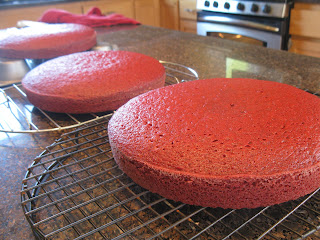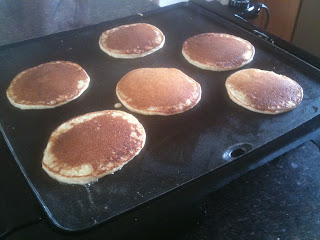Red Velvet Cake
Red Velvet Cake, Baked and Photographed by Rashel Fitchett
Red Velvet Cake is different than most cakes which call for milk and butter. Red Velvet Cake calls for buttermilk, a large amount of oil, vinegar, and red food dye. The buttermilk and vinegar give this cake a slight "tang", the oil gives it a more moist consistency, and the food dye...well, we all know Red Velvet Cake is supposed be....red.
Here is a recipe for Red Velvet Cake that makes a large, three-layered, cake.
Dry Ingredients:
3 3/4 C unbleached, all purpose flour
3 C flour
6 T cocoa powder
1 1/2 t salt
1 1/2 t baking soda
Wet Ingredients (at room temperature)
3 eggs
2 1/2 C canola oil
1 1/2 C buttermilk
1 1/2 T vinegar
1.5 t vanilla
2 oz red food coloring
Directions (see below for a pictorial, step-by-step)
1. Get out all ingredients. Let the wet ingredients sit for 30 minutes or until they are at about room temperature (you'll get a better lift of your cake batter if you do).
2. Preheat oven to 350 degrees.
3. Grease and flour three round cake pans.
4. In a large bowl, mix dry ingredients with a whisk for 3 minutes.
5. In another large bowl, add wet ingredients as follows:
-lightly beat eggs
-slowly add oil into eggs while stirring with a whisk
-slowly add buttermilk while stirring with a whisk
-add vinegar, vanilla, and red food coloring all at once
-stir with whisk for about 1-2 minutes, no lumps should be left behind
6. Pour about 2 1/2 C of the batter in each of the three prepared pans, using all the batter equally amongst them.
7. Arrange all three pans in the preheated oven so than none are touching the edges of the oven and with a space in between all pans. If they don't fit, first bake two, then bake the third.
8. Bake for 30 minutes.
9. Remove from oven and let sit in their pans for 10 minutes to cool.
10. Remove your cake from the pan,
using the plate-flip method, and let sit on wire cooling racks to cool completely.
11. Wrap in plastic wrap and tin foil and freeze for easier icing later.
Here are my ingredients coming to room temperature.
I prepare cake pans by wiping with crisco and dusting with flour.
Whisking dry ingredients aerates the flour, giving your finished cake "bounce".
I gently beat my eggs with the whisk.
Slowly add the oil, stirring as you pour. This incorporates the fat evenly in the protein.
Add the buttermilk in the same way. This is where the "wet" part comes into play.
Add the vinegar, vanilla, and color. Jeez, this is red!
Add the wet to the dry.
Stir well, getting rid of large lumps.
Evenly distribute the batter amongst the three pans.
After 30 minutes of baking in the oven, let them rest in their pans for 10 minutes.
Then, cool them completely on racks. See than nice rise to the tops...that is that room temperature thing ;).
I'll be wrapping these in plastic wrap and tin foil and then freezing them so that later, when I ice them, they are hard and don't fall to crumbly pieces as I am pushing the cream cheese frosting across the tops and sides. More on that later.......












































